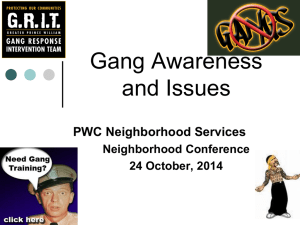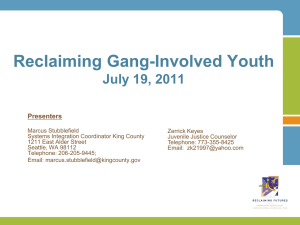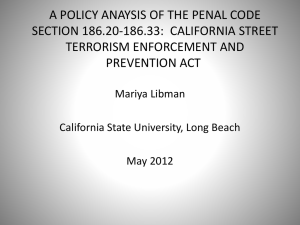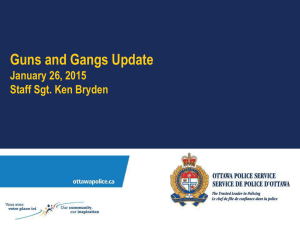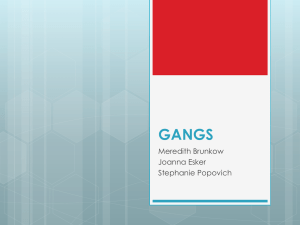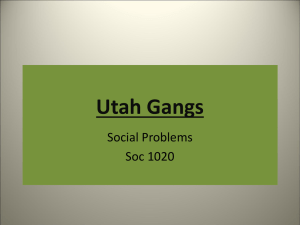Alberta Gang Reduction Strategy
advertisement
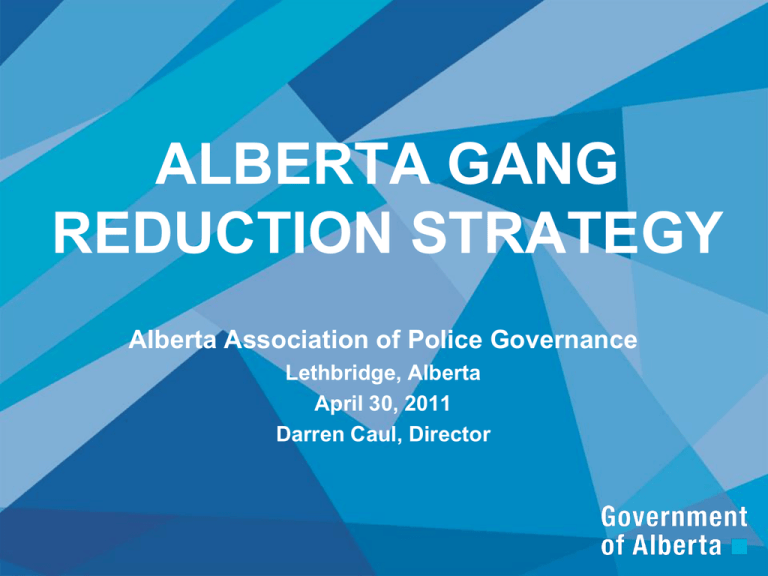
ALBERTA GANG REDUCTION STRATEGY Alberta Association of Police Governance Lethbridge, Alberta April 30, 2011 Darren Caul, Director Overview • Gangs as Criminal Organizations • Statistical Overview • Alberta Gang Reduction Strategy • • • • Awareness Prevention Intervention Enforcement • Community Engagement Gangs as Criminal Organizations What is a Gang? • A group of people, who through the organization, formation or establishment of an assemblage, share a common identity. • Section 467.1(1) of the Criminal Code defines a "criminal organization“, however organized, as: Three or more persons… involved in the commission of one or more serious offences, that would likely result in the direct or indirect receipt of a material benefit… Criminal Organizations • Size, structure, membership and rules vary. • Some, such as Outlaw Motorcycle Gangs (OMG) are highly structured and sophisticated: I. membership in “chapters” throughout the world; II. strict written rules of conduct; and III. (some) “legitimized” business activities. • Others, such as youth / street gangs, may be loosely organized in structure and location, fluid in membership and opportunistic in their criminal activities. Violence and Intimidation Gangs use violence to intimidate other gang members, communities, police and officials. • Violence is unpredictable and has sometimes claimed innocent victims. • Gangs have been responsible for many driveby shootings and stabbings. Diverse Criminal Activities Trafficking of illegal drugs is the principal type of criminal activity undertaken by gangs. • Gangs also involved in extortion, money laundering, financial / identity theft crimes, (i.e.: skimming PIN numbers). • Gangs attempting to infiltrate legitimate private and government information systems to steal personal data. • Involvement in human trafficking is on the rise. Statistical Overview Canada / U.S. Comparison Canada • Approx. 900 gangs (2008) United States • Approx. 20,000 gangs • Approx. 11K members (2006) • Approx. 1M members • 1 member / 2,836 citizens • 1 member / 309 citizens • 69,299 police • 883,600 police (2008)* • 1 officer / 492 citizens • 1 officer / 353 citizens Sources: Statistics Canada; National Gang Threat Assessment (2009) ; CISC Situational Overview of Canada Street Gangs (2009); CISC (2010) U.S. Census Bureau; US Bureau of Labour Statistics Homicide Rates (Canada) Homicide Gang-Motivated • 610 homicides (2009) • 124 gang homicides (2009) • Firearm used 30% • Firearm used 75% (2008) (1997 to 2008) • Clearance Rate=80% (2006) Average Age: Victim = 35 Accused = 30 • Clearance Rate=45% (2006) Average Age: Victim = 28 Accused = 23 Homicide Rate Decreasing since mid-1970s Gang-Motivated Homicides Increasing since 1991 http://www.statcan.gc.ca Number of Gang-Motivated Homicides in Alberta (1999-2009) 40 35 30 23 22 20 20 15 13 10 4 9 5 8 4 0 1999 2000 2001 2002 2003 2004 2005 2006 2007 2008 http://www.statcan.gc.ca 2009 Gang crime affects all Albertans! Gang-Motivated Crime is Expensive! • Drain on emergency services. • Drain on the health care system. • Decline of property value. • Increased taxes and insurance. • Drain on the justice system. Gang investigations and prosecutions are extremely complex and expensive. One gang related homicide investigation can cost millions. Gang-Motivated Crime is Expensive! • Loved ones injured or killed. • Increased crime and fear of crime. • Creates neighbourhood disorder. • Lost potential of young people. Most disturbing are the human and social costs resulting from the criminal and exploitive activities of gangs which often target young and vulnerable populations. Cost of Incarceration • $135,870 to incarcerate an offender in a maximum security institution. • $87,498 in a medium security institution. A four-year university degree costs less than incarceration for one offender for one year. Source: http://www.csc-scc.gc.ca Incarceration Rate / 100,000 adults (2009) 800 700 600 500 U.S. U.K. Australia Canada France Germany Japan 400 300 200 100 0 - http://www.prisonstudies.org/ Alberta Gang Reduction Strategy (AGRS) Why was the AGRS developed? • “Keeping Communities Safe” Task Force Report (2007) called for action on gangrelated crime • An important component of the Alberta’s Crime Prevention Framework • Emerging gang violence in Calgary, Edmonton and Hobbema (2008) How was the AGRS developed? 1. Cross-Ministry Collaboration 2. Consultations and Summit 3. Logic Model Process Deliverables: Deliverables: Deliverable: • Ideas for consideration • Logic Models • What Was Heard Report • Discussion Guide • Alberta Gang Reduction Strategy What is the AGRS? • GoA’s “comprehensive blueprint for action on gangs and gang violence.” • Mission: To suppress gang activity and reduce the influence of gangs in Alberta by working with community partners to promote strong and vibrant communities 10 Strategic Directions + 28 Actions Two Goals Goals of the AGRS GOAL 1: Reduce gang-related crime and violence in Alberta. GOAL 2: Strengthen ongoing efforts to develop an integrated, comprehensive, and sustainable approach to gang suppression. Balanced approach of awareness; prevention; intervention; and enforcement. Awareness Strategic Direction 1: Build community capacity through increased public awareness about issues related to gang activity. Education & Awareness Actions • Deglamorize the gang lifestyle and provide young people / parents with meaningful information. • Educate young people / parents / other meaningful adults about risk/protective factors. • Reduce influence of gangs on individuals / communities through a continuous, balanced approach that promotes / publicizes existing prevention and intervention programs. Action to Date and Next Steps • Research, including focus groups and survey, to determine effective means and messages for campaign. • Province-wide, multi-year education and awareness campaign to be launched summer 2011. Prevention Strategic Direction 2: Support prevention and early intervention programs that address risk factors to dissuade young people from joining gangs. Prevention Actions • Increase opportunities to provide training and alternatives to gang involvement for children and at-risk youth through the use of schools and community centres. • Support sustainability of existing cross-ministry initiatives to support early childhood development for children <7 yrs. • Determine how School Resource Officers can best be used to reduce the ability of gangs to recruit young people. Prevention: Action to Date • Through Safe Communities Innovation Fund (SCIF), $8.2M granted to support 10 community projects focused on gangs. • Through Civil Forfeiture Office (CFO), $500k granted (Dec. 2010) to support 12 projects focused on youth at-risk of gang recruitment. “Crime is more likely to occur when an individual’s bond to society is attenuated.” Source: The Annuals of the American Academy of Political and Social Science, 602, p. 22 Intervention Strategic Direction 3: Develop exit strategies to help those who wish to leave the gang lifestyle. Intervention Actions • Design and implement intervention programs for gang members and potential gang members in communities. • Support the development of local and provincial intervention strategies that reduce Aboriginal peoples’ involvement in gangs. • Develop exit strategies in both adult and youth correctional institutions. • Expand intervention programs for individuals under court-ordered community supervision. Intervention: Action to Date • Through Civil Forfeiture Office (CFO), >$300k granted to support gang intervention projects, including EPS “Plan B” and CPS “YARD”. Enforcement Strategic Direction 4: Continue to promote integration among specialized law enforcement units and encourage close working relationships with community stakeholders. Enforcement Actions • Ensure sufficient surveillance capacity exists to monitor certain forms of gang activity. Alberta Law Enforcement Response Teams (ALERT) Safer Communities and Neighbourhoods (SCAN) Units • Establish common criteria (definitions) to ensure a consistent approach to prioritizing gang targets among law enforcement agencies in Alberta. • Expand use of civil forfeiture legislation and criminal forfeiture process. Enforcement: Action to Date • Increased personnel at ALERT from 219 to 396 (2008-10). • In 2009-10, ALERT took over $100M worth of drugs off the streets of Alberta; charges laid against 853 people. • Added 300 new frontline police officers. Legislation: Action to Date Safer Communities and Neighbourhoods Act • Supports community to target and shutdown properties Mandatory Reporting of Gunshot Stab Wound Act • Requires health care facilities and providers to report gun shots and stab wounds to police Amendments to the Gaming and Liquor Act • Enables police to remove gang members from licensed premises Body Armour Control Act • Prohibits possession of body armour without permit Amendments to Traffic Safety Act • Prohibits “aftermarket” armoured vehicles Victims Restitution & Compensation Payment Act (April 2010) Permits province to: • seize instruments of crime or any property used to commit a crime; and • seize property & profits gained from unlawful acts. To date, >$22M gross seized including 173 dealer cars and 50 grow houses = $2.2M net. Net proceeds fund victim services and crime prevention. Community Engagement: Get Informed! Get Involved! For those actively engaged in reducing gangs and gang crime in Alberta, a virtual community was established at: http://agrs.justice.alberta.ca/ Website Includes: • videos • discussion forums • virtual resource library • blog • polls • live training webcasts Concluding Remarks 1. Gang crime and violence is a growing problem in Canada. 2. Additional resources and significant legislation continues to unfold in Alberta to suppress gangs. 3. Enforcement and incarceration, alone, is not the answer. 4. Alberta Gang Strategy reflects a balanced approach of awareness, prevention, intervention and enforcement. 5. Growing body of literature about the risk factors leading young people into gangs; prevention and intervention efforts are equally critical, at this time. 6. Gang crime is costly. It affects all Albertans. 7. Solutions require collaboration among police, government and communities. Thank You! Darren Caul Director, Alberta Gang Reduction Strategy Email: darren.caul@gov.ab.ca Tel: 780.643.1347 Website: http://agrs.justice.alberta.ca/
